 |
|
 |
2021
August
31
|
Welcome to the world, Stephen Barrett!

Our newest grandson, Stephen, was born today just after noon.
We don't have a picture of him yet, so this illustration was contributed by
his sister Mary. More news soon!

[Note added September 14:] Here's his picture (taken September 10).
Stephen had heart surgery shortly
after birth to correct transposition of the great arteries.
He is making a very good recovery and has been home for several days.
Permanent link to this entry


|
2021
August
28
(Extra)
|
Hoist with my own audio settings
[Previously posted on Facebook.]
Audio equalization settings matter...
...and modern digital stereos can alter the sound a lot more than old analog tone controls
or graphic equalizers could.
Into the car I drive to work, I brought some CDs of Melody's that I was not too familiar with.
And was disappointed.
Why is the singing of Loggins and Messina such a muffled mess?
When did Kenny Loggins start doing head-banging hard rock?
It turned out that during some recent electrical work, the settings of my car CD player had gotten garbled.
There was a very strong bass boost and also a loudness contour (bass and treble boost).
The combined effect of these was to muffle the singers and amplify the percussion so that my
old, cheap speakers were overwhelmed by drumbeats and couldn't reproduce anything else.
About half of the music was just gone.
I spent 15 minutes putting all the settings back to normal, and
now it sounds like an entirely new team of musicians!
Good to meet you again, Loggins and Messina!
(New speakers are coming soon, too, I think!)
In case you're wondering, Shakespeare's phrase "hoist with his own petard"
means "lifted (i.e., injured) by his own bomb."
Permanent link to this entry


|
2021
August
28
|
Saturn

Here's Saturn again, with the same setup as three nights ago: C8 EdgeHD, 2× extender,
and ASI120MC-S camera; best 50% of about 1800 video frames.
Again you can see some asymmetry in the rings, which is real. On the right-hand side there is a streak in the
outer ring that is not concentric with the ring itself. It may be a processing artifact; I can't completely confirm it
on pictures taken with larger telescopes; but it may be a shadow effect (the rings cast shadows on themselves).
Other differences between the left and right ansae (that's what we call the parts of the rings on the two sides of the
planet) are real.
Permanent link to this entry
Jupiter and the satellite Io
Using the same setup, I photographed Jupiter and its satellite Io as the satellite approached and then moved
in front of the planet.



In the last picture, the shadow of the satellite is obvious, but the satellite itself is very hard to see
because it is the same color and brightness as Jupiter itself. The red lines point to it.
Permanent link to this entry


|
2021
August
26
|
Saturn is stranger than you thought
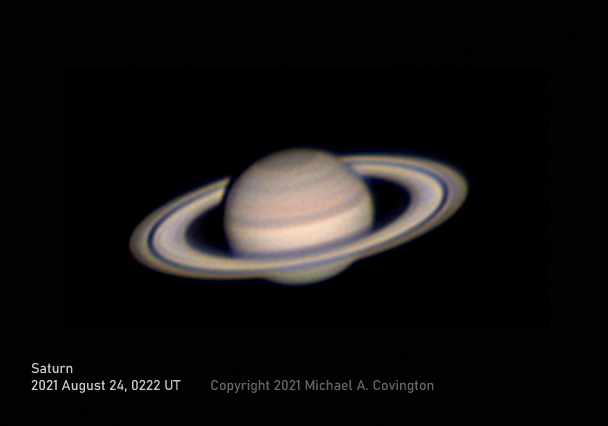
This picture of Saturn, taken with my 8-inch telescope on August 23, shows some recently discovered things that astronomers
didn't believe (even when they saw them) until space probes confirmed them, because they were too strange
to be believed.
Until the digital imaging era, the best pictures of Saturn were hand-drawn by experienced observers.
These observers took it for granted that the rings were uniform and symmetrical and that the polar caps
were circular. How could they be otherwise?
But as you can see here, the rings aren't the same on the right as the left. They are lit differently
and also slightly different widths.
This is confirmed by photographs taken by others.
There may even be a streak in the rings (on the right) that is not
concentric, though it could be a processing artifact.
The rings are in fact somewhat chaotic because they consist of swarms of small
rocks orbiting the planet, affected by the gravitational pull of the satellites,
which, of course, orbit the planet at different rates and pull different regions
of the rings differently.
On some amateur pictures, but probably not mine,
you can even see that the dark polar cap is hexagonal, not circular!
The hexagonal shape is caused by six storms evenly spaced around the outside
of the polar cap. Its discovery startled scientists, but now that we no longer assume
the cap is circular, we don't overlook the hexagonal shape when a picture shows it.
Taken at my home in Athens, Georgia. Celestron 8 EdgeHD, 2× teleconverter, ASI120MC-S
camera, stack of the best 50% of 2,043 video frames.
Permanent link to this entry
Jupiter and a satellite
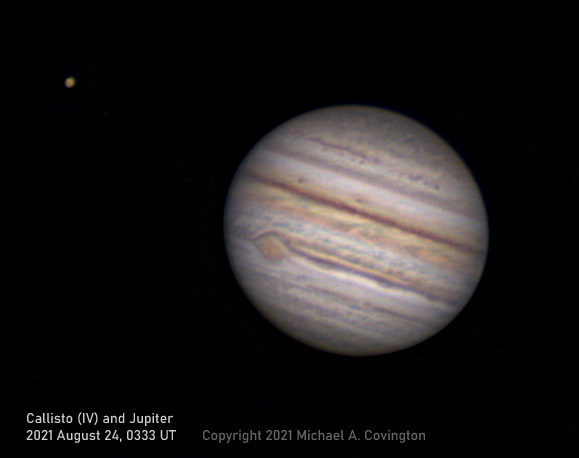
Here's one of my best Jupiter images ever, and you can see at least a bit of surface detail
on the satellite Calliso (Satellite IV). Same setup as above, best 50% of 4,310 video frames.
Permanent link to this entry


|
2021
August
22
|
Fellow Christians: Willful foolishness is a sin
Today's entry is addressed to my fellow Christians.
Non-Christian readers may find it informative about what Christians
really, historically believe, as distinct from recent fads and
aberrations. These are points on which practically all Christians
have long agreed.
(Originally posted on Facebook.)
Fellow Christians: The following are some things on which I'm in the process of getting my thoughts together, and I'll write more later.
Some basic points of Christian morality have been lost as "Christians" chase after political and medical quackery.
I think the root of the corruption is that people don't want to face difficult and complex facts. So they eagerly swallow foolish or dubious beliefs to spare themselves the trouble, and to pretend that they know all that they need to (Proverbs 26:16).
The Bible is full of warnings about false teachers and people with "itchy ears" (2 Timothy 4:3-4). I don't know if enough people realize that false teaching could be about politics or medicine, not just religion.
The Bible says we have a moral duty to seek wisdom, and that deliberately being foolish is a sin. The whole Book of Proverbs is about this.
Part of wisdom is knowing the limits of your knowledge. You're not an expert on something just because you read one article or found one website you like. You can make Christianity look very silly if you show off your ignorance. You don't have to have an opinion about everything. Learn to say, "I don't know."
Refusing to take medical precautions and saying "faith over fear" or "God will protect me" is flatly unbiblical:
"Thou shalt not put the Lord thy God to the test" (Luke 4:12).
The Bible says it is wrong to "bear false witness" (accuse people of wrongdoing without good evidence and a good reason for being involved). Most conspiracy theories are massive violations of this commandment. So is most gossip. In fact, gossip is singled out as a sin (Proverbs 20:19 etc.) even if the content is not false.
Loving your neighbor is a VERY important Christian teaching; standing up for your own rights is not.
In fact, if you refuse to make sacrifices to benefit others, you give the impression that you might not have even
heard of Jesus.
The Bible tells us to respect legitimate authority, including government,
even if it is bad. (See 1 Peter 2:13-17, and note that it's talking about the Roman Empire,
not some "Christian" government.) Eric Metaxas is unbiblical when he says
to refuse government medical recommendations "just to be a rebel."
The Bible nowhere promises us earthly politicians who are worthy of our unquestioning support. We should support candidates as far as they will do good things (or at least better things than their opponents), but we should never lower our moral standards out of "loyalty" to human beings, or for the sake of "winning."
The Bible does not say you have the "right to your own opinion" if that means a
right to believe things that aren't true. There are plenty of warnings about this.
"Let not arrogance come from your mouth; for the Lord is a God of knowledge,
and by him actions are weighed" (1 Samuel 2:3) for instance.
Imagine that God is going to quiz you about what you think and say.
I have noticed that people who promote strange beliefs often don't fully believe them themselves.
They say dramatic things to impress other people, or to impress themselves while they avoid thinking
about complicated facts. This is a common characteristic of gossip, but also of quackery and
conspiracy theories. If you really believe your doctor is part of an evil, deluded conspiracy,
then why don't you switch to a different doctor? If you think everything in the newspapers is false,
why do you comment constantly on real events that are reported there?
(The "mainstream media" say we withdrew from Afghanistan; is that false?)
You talk the conspiracy talk out of bravado, but it's not what you really believe, deep down.
I am concerned that many of the Americans who have put on "Christian" as a cultural and political label
have no real commitment to Christ at all. Their thoughts are entirely on political goals,
and the church is a means, not an end. We are going to have a time of repentance and winnowing,
and we may find out that the church in America is a lot smaller than we thought.
Permanent link to this entry


|
2021
August
20
|
Down a musical rabbit-hole...
One thing I've realized recently is that for the past fifteen years or so, I've been listening
to far too little a variety of music. I've heard plenty of music, but rather narrowly selected.
Let me explain.
Over the years, we've all switched from listening to the radio to retrieving music from vast
online libraries. That's good, right? It means we can listen to anything we want...
...but only if we can retrieve it by name...
...and only if it occurs to us to do so.
I realized that it had become my habit to type in the name of one or two favorite composers or
performers and listen to whatever came up. That would be exactly what I asked for, and nothing else.
I didn't get bored; Vivaldi, for instance, composed a vast amount of music, so I could go for weeks
without hearing the same piece twice. But if I asked for Vivaldi, I never heard Simon and Garfunkel
or even Tchaikovsky. Of course, there are classical mix channels, but they usually string together
very similar works.
I lost what I might call "second-tier music," music that I know about, and enjoy hearing, but which
is not the first thing I would think of when asked to ask for something.
And, worse, I lost "third-tier music," the music I've long been accustomed to hearing — mostly
long-standing popular music standards, but also minor classical music — where I had never paid
much attention to the name of the piece or the performer, and might not be able to call it up by name
even if I remembered it clearly.
If you listened to the radio a lot back in its heyday, you have in your background
a lot of third-tier music, songs that
bring back pleasant memories, and are worth hearing occasionally, and you'd be sad if you absolutely
never heard them again.
The remedy is to listen to mix channels that have a wide-ranging mix, and tolerate (as we did in
radio days) the channels on which you dislike about a third of the songs,
in order to also hear the songs you like and would not otherwise have retrieved.
At work, I've been enjoying
Pandora's "Easy Listening Radio" channel,
which is often played on the office
sound system.
This channel is not what "easy listening" meant in the 1970s (instrumental covers of songs).
It consists mostly of soft rock from about 1970 to 1985,
and I've been delighted to hear songs I hadn't heard in decades — even if I didn't like
them enough at the time to want to seek them out.
They are at least the soundtrack of an important part of my life.
I am surprised at how popular the music of the 1970s still is. That's when a lot of musical
creativity happened. There's 1970s music everywhere today. It's easier to find than 1990s music
or 2000s music!
But the "Easy Listening Radio" channel does have a quirk — it tends to have
runs of similar songs, as if it were doing a random walk through a search space rather
than a completely random shuffle.
For instance, this afternoon, there was about an hour dominated by The Eagles,
and then about an hour of more country-like songs that I wasn't familiar with and didn't particularly
like, and then it came back around to more familiar fare.
Other mix channels will likewise fill the bill. I'm determined to branch out.
Permanent link to this entry


|
2021
August
17
|
Nether lands
High on this mountain,
the clouds down below,
I'm feeling so strong and alive.
From this rocky perch
I'll continue to search
For the wind
And the snow
And the sky...
Melody and I have been making a project of
sharing our favorite music with each other; after years of using headphones a lot,
and spending time in different places during the day, we hadn't been hearing enough of what the other was
listening to.
And today I want to introduce you to one of Melody's favorite songs, which I very much like,
Dan Fogelberg's "Nether Lands."
We actually prefer the performance by Donna Summer on the "Tribute" album, which (we think) has the same
instrumental track as the original. Some links:
Sung by Dan Fogelberg: YouTube Spotify
Sung by Donna Summer: YouTube Spotify
And definitely read the lyrics too.
(Alternative link for lyrics.)
The song is not about the Netherlands (Holland). The title refers to lower (nether) lands seen from a mountain.
And if you follow through to the end, you may share my conclusion that Dan Fogelberg was at least as good a
poet as Robert Frost. In fact, the art of poetry in modern times may be flourishing in songs like these
more than in "serious literature."
The music is also very elaborate. Listen carefully!
Permanent link to this entry


|
2021
August
14
|
Quick and lazy astrophotography: RS Ophiuchi in outburst
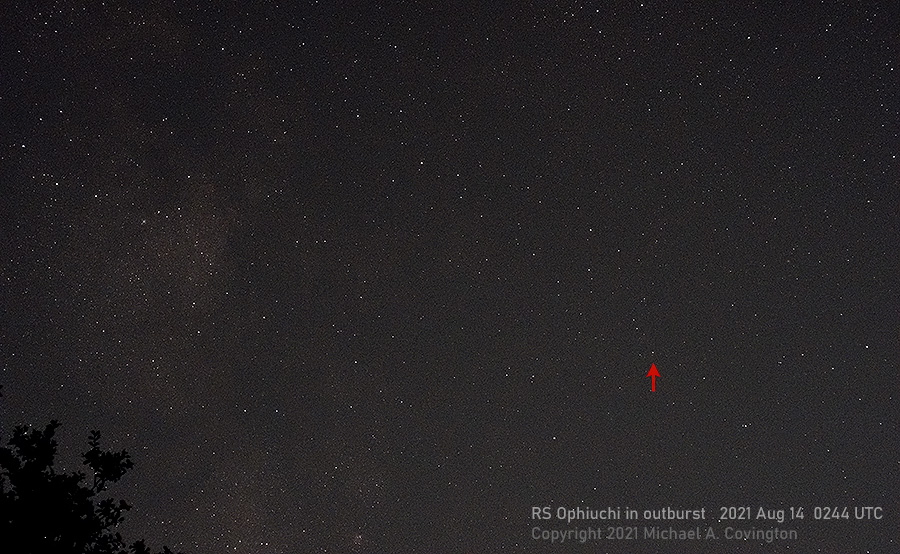
The recurrent nova RS Ophiuchi is in outburst, and despite mixed weather (partly clear sky with
scattered clouds and distant lightning), I managed to sight it with binoculars and then
photograph it last night.
The photography was very low-tech, and you can tell it. This is a single 3-second exposure with a
Nikon D5500(a) on a fixed tripod, with a 50-mm lens at f/2.8. An arrow indicates the star.
To the left, you see the Scutum star cloud, and at the bottom edge, left of center, one of the nebulae
in Sagittarius (M17, I think).
The granular look of the background is an artifact of the sensor, combined with high-contrast processing.
It would have been much better to take ten pictures and stack them, but a thunderstorm was approaching!
Permanent link to this entry


|
2021
August
12
|
A thing with no name
Or, "Can you get DuPont connectors at Digi-Key?"
[Revised.]
Jeff Duntemann once wrote an essay titled,
"I've been to distraction on a thing with no name,"
and today I report a worse case of the same thing.
One of the most common electronic components has no agreed-upon name.
And it's due to a classic trademark failure, where a trademark failed to become the name of the
product, but no generic name emerged either. Melody pointed this out to me.
It's worse than what happened to Kleenex or Scotch tape or aspirin
because the original product failed to remain well known and define the market,
and no strong competitor had a distinctive name — they
were lost in a crowd of similar but not equivalent products.
So...
What do you call the crimp connectors in these pictures? If you ask ten electronics experts,
you'll probably get five names, or more. (Just calling them crimp connectors isn't good enough;
there are a zillion other kinds of crimp connectors.)
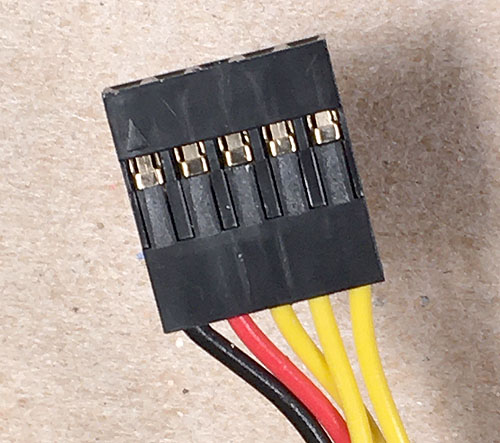

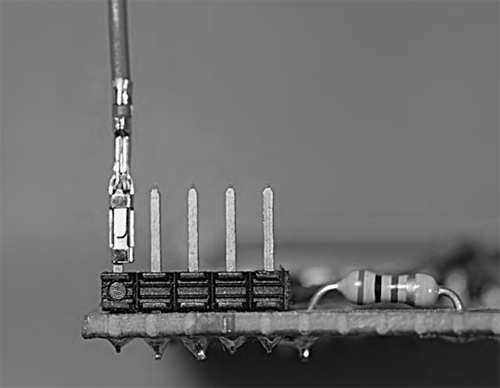
These are close equivalents of the old DuPont Mini-PV connector,
but there's no telling who made these.
The Mini-PV line is still made by Amphenol,
but it's a higher-priced premium product
(an example here).
And that's the problem.
Competitors, domestic and foreign, make closely equivalent products that cost half as much, or less.
And there's no generic name to tie them together.
In recent years, a lot of people have started calling these
"DuPont connectors," though
they're not the only connector DuPont used to make,
and the substitutes that are popular on the market are Chinese-made imitations.
So what do you order from an American distributor?
What you probably want is
the Molex SL series, specifically:
0016020086 (Molex SL 70058 series) socket connector
0016020107 (Molex SL 70021 series) pin connector
0050579304 (Molex SL 70066 series) stackable housing
(available in many sizes to hold different numbers of contacts).
Those are actual Digi-Key ordering links. Three notes:
(1) The commonly used black housings are the "stackable" ones (the plainest kind).
There are many other kinds of housings with fins and ridges to make
them fit into specific sockets.
(2) When people say "Molex connectors" they usually mean a different, larger one also made by Molex.
These are the SL series.
(3) Knowledgeable people tell me major manufacturers' products are much more reliable than
imported imitations, due to the quality of the springs.
Many others are similar.
The Harwin
M20 series is a very good equivalent — except
that it doesn't include pin contacts.
The AMP (now TE) MTE and AMPMODU are approximately equivalent, or at least closely similar. Note that AMP
is not related to Amphenol.
What about crimping tools? If you spend hundreds of dollars for the exact crimp tool specified
by the manufacturer, you're locked into one brand, because the different versions (including Chinese),
though closely equivalent, have slightly different dimensions before crimping.
If you do your crimping by hand with a generic tool and
pay attention, you can move freely between manufacturers.
There are many YouTube videos about how to crimp these connectors, and some are better than others.
Judge your results by the first picture above (except that in the fully crimped one, the wire extends
too far).
I shall return to this. In the meantime, what do we call them?
Maybe "DuPont Mini-PV-style connectors" or "Molex SL-style connectors"?
Is "DuPont-style connectors" good enough?
Simply calling them "DuPont connectors" seems like a misnomer, and yet it seems to have acquired
a perfectly clear meaning.
It reminds me of the term "RCA plug," describing a plug not made by RCA in my lifetime,
and possibly never.
Generically, these are "2.54-mm inline socket connectors in stackable housings" (roughly).
Permanent link to this entry


|
2021
August
8
|
In the fourth wave

The fourth wave of COVID-19 is in full swing, and in Florida, has exceeded the maximum case rate
from January. In Georgia, like most of the country, it hasn't risen that far, and in the UK, for
some unknown reason, it shot up and then has started to fall just as quickly.
In this graph, the spike in Georgia around -280 is a reporting anomaly. It has been in
the charts the whole time.
This wave is dominated by the Delta variant of the virus, which is much more contagious than the
original one (Alpha, uncontrolled spread rate, R=8 versus R=2.5). The actual spread rate in Georgia right now
is about 1.4.
We live in a strange world of haves, have-nots, and deniers.
Those of us who are fully vaccinated need to avoid crowding and wear masks in public places, but apart
from that, our lives are not very much restricted.
We are very unlikely to become severely ill, no matter what happens.
Unvaccinated people are in more danger than ever, but many of them simply deny it.
In fact, people refusing to wear masks are mostly unvaccinated, according to surveys.
Vaccines protect against severe illness from Delta, but they do not reduce the spread of it as much
as they reduce the spread of Alpha. That is why masks are back,
even for the fully vaccinated. I enjoyed working in the UGA Science Library without a mask on August 5;
it was almost like old times; but now UGA is going back into masks.
What's special about Florida? Mainly, I think, a political and cultural environment (and a governor)
that do not take COVID seriously. People don't wear masks or avoid crowding there. The governor blames
the Delta variant on infected immigrants coming across the border from Mexico. There is no evidence for this
(whatever problems there may be at the border, they're not the main source of COVID Delta in the United States),
and some of us have noticed that Florida does not share a border with Mexico.
Vaccination is available free, without appointments, in many pharmacies, and nearly half the public won't
get vaccinated. I question the rationality of people who will buck the advice of the entire medical profession
just because "somebody said" or "I heard" something different. If you can question your doctor, why can't
you question the non-medically-qualified crank who is telling you to disobey your doctor? Independent
thinking indeed.
Deeper down, I think the psychology of it is this. As Trump becomes increasingly delusional and detached
from conservative politics, the people who were supporting him have hit their limit, and have switched over
to the COVID-denial cause. But COVID-deniers are no longer able to persuade anyone, so they have switched again,
to just making absurd statements and wasting people's time.
And this still manages to deter some less-informed people from being vaccinated, and costs lives.
Permanent link to this entry


|
2021
August
6
|
"Stand up!"

Nature photo of the day.
Permanent link to this entry


|
2021
August
4
|
Two little-known nebulae in Cygnus

Last night I was again able to do astrophotography — clear nights are not quite as
rare as they have been. Here you see NGC 6823, a star cluster with nebulosity
in Cygnus. A better picture of it will require a lot more exposure, but you can see that the
nebula is red (indicating fluorescent hydrogen) and has a prominent "elephant trunk" to the
upper left of center. To the lower right, one of the bright stars appears comet-shaped because
it is surrounded by gas and/or dust; that is NGC 6820.
This is a stack of twelve 2-minute exposures with my Celestron 8 EdgeHD, f/7 compressor, and
Nikon D5500 (H-alpha modified), autoguided on the iOptron GEM45 mount. Because of clouds
coming in, I didn't get the 20 exposures that I hoped to. Also, the air wasn't all that clear.
A better picture of his nebula would probably require 40 exposures and, if possible, clearer air.
Permanent link to this entry
Saturn and the Seeliger Effect

This isn't a great picture of Saturn — it was rather low in the sky, and the air was
unsteady — but it illustrates something important. Notice how the brighter ring (Ring B)
is much brighter than the ball of the planet. That is not how it normally looks.
The trick is, the rings are made of a swarm of loose particles, and right now, Saturn and Earth
are in approximately the same direction from the sun. That means we're looking at the particles
from the direction from which sunlight falls on them. None of them are dimmed by the shadow of
another particle falling on them. In just a few days, we won't have that straight-on view,
and the rings will be noticeably dimmer. Click here
to see a comparison picture.
Stack of the best 75% of about 2000 video frames; Celestron 8 EdgeHD (f/10), 2× extender,
and ASI120MC-S camera with UV/IR-cut filter (which is my usual planetary setup).
Permanent link to this entry
KiCad installs without activating its own libraries
Version 5 of KiCad electronic design software is plagued
by a notorious quirk — apparently a bug in the installer. (KiCad is free, excellent, and
a fast-emerging industry standard. I recommend it!)
Although a lot of component libraries come with it, when it's first installed it doesn't see them.
You can have the weird experience of starting to draw a circuit only to find that there are no
components available at all.
In fact, the libraries are there, but KiCad has not been told so. Here's how to
put things right.
(1) In the top menu navigate to Preferences, Manage Symbol Libraries, Global Libraries.
This dialog box will pop up:

Note: If you see a set of libraries starting with "4xxx", as in the picture, you do not
have this problem; your libraries are already working properly.
Most likely you will see no libraries in the list. If there are libraries
in the list, you probably want to delete them, especially if you're not sure where they're from.
(2) Click on the tiny folder symbol marked by the arrow. It is the "Add existing library" button.
(3) Navigate to C:\Program Files\KiCad\share\kicad\library (mutatis mutandis)
and add all the files.
(4) You will also need to do something analogous at Preferences, Manage Footprint Libraries,
except that KiCad will offer to do the setup for you.
If it doesn't, then proceed to the
Global Libraries tab, click on the tiny folder,
and navigate to C:\Program Files\KiCad\share\kicad\modules.
The list there starts with "Battery" rather than "4xxx".
You can also get KiCad libraries from Digi-Key and Octopart, among others, to give you information
about even more components.
Permanent link to this entry


|
2021
August
1
|
Some nature photography by Melody
On June 26, Melody and I did something we had done often in our younger days --- nature photography.
We went to Sandy Creek Park, and Melody wielded the Nikon D5300.
We are both fairly new to serious daytime photography with DSLRs (despite the fact that I've done
a huge amount of astrophotography with them), but I was impressed with what she produced. Here
are four of the best:




The second picture was a high-dynamic-range tour de force, made from the raw file, opened with
adjustments in Photoshop CS5.5; the others were given only minor adjustment and cropping.
There will be more!
Permanent link to this entry
Capacitor leakage tester and former

Today I finally finished an electronic project that I had started in October or November
of 2019. It measures leakage of capacitors (mainly electrolytic capacitors) using a row of
LEDs as a logarithmic-scale bar graph, and it can also be used to re-form capacitors by
keeping them charged for hours or days. Unlike my vintage Heathkit capacitor checker, this
one only goes up to 24 volts — enough for most modern needs — and is calibrated,
so you can read off the leakage in microamps.
I can't publish the circuit, for two reasons. First, it's based on (though not copied from)
a proprietary circuit that Paul Carlson provides to his Patreon subscribers.
(I subscribed and got full permission to build and adapt it, but not to republish it.)
Click on the link to see not only his tester, but also a Heathkit one just like mine, which
was the inspiration for it.
Second, it uses an IC that is no longer on the market, the
LM3915 logarithmic bar graph display driver.
This chip is a classic 1980s specialized analog IC, and I've used it before;
the logarithmic scale is great for photographic light meters.
But it's not state-of-the art; today the same job would be done with a programmed microcontroller.
In some ways, this project is a 1990s nostalgia piece. It's neat, it does its job, but a more modern
version would have a microprocessor and a digital readout. I built it to build my experience with
several relatively new things, especially inline (DuPont) crimp connectors and K100LD lead-free
solder.
Next up: It's finally time to get to exploring the Arduinos that I got about nine years ago.
And then the Raspberry Pi.
Permanent link to this entry
Dangerous cheaply made DC power socket
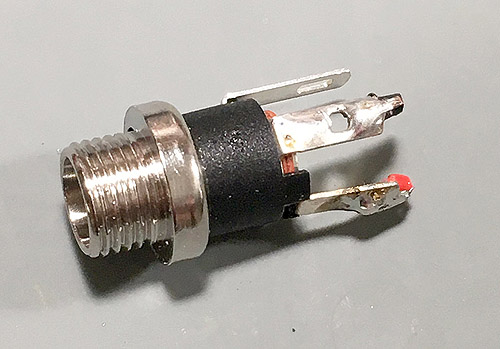
Several power connectors that look like this are now in my trash can.
One was installed in the capacitor tester, which mysteriously failed to turn on
this afternoon, after I felt a suspicious roughness when inserting the plug
from the 24-volt, 1-amp wall transformer that powers it.
I found the connector
shorted from barrel to pin. Fortunately, the wall transformer was of a new, high-quality type
and was smart enough to shut down, undamaged, rather than burning out or overheating something else.
So I replaced the connector, and after removing and reinserting the plug a couple of times,
I had the same problem again!
What happened is that the act of inserting the plug was buckling the spring that should
connect to the barrel, so that it also shorted to the pin.
I don't know where I got these sockets. They have no trademark or other identifying information.
They are a close imitation of an American-made Switchcraft product, and fortunately, I had a
couple of the Switchcraft ones (with trademark!) and was able to put one in.
No more problems, and I can see that Switchcraft's spring is made so that it won't buckle.
I am rapidly becoming convinced that cheap (usually Chinese-made) imitations of American electronic
components are not to be trusted. You'd think they couldn't mess up a power connector.
But they did!
Permanent link to this entry


|
|
|
This is a private web page,
not hosted or sponsored by the University of Georgia.
Copyright 2021 Michael A. Covington.
Caching by search engines is permitted.
To go to the latest entry every day, bookmark
http://www.covingtoninnovations.com/michael/blog/Default.asp
and if you get the previous month, tell your browser to refresh.
Portrait at top of page by Sharon Covington.
This web site has never collected personal information
and is not affected by GDPR.
Google Ads may use cookies to manage the rotation of ads,
but those cookies are not made available to Covington Innovations.
No personal information is collected or stored by Covington Innovations, and never has been.
This web site is based and served entirely in the United States.
In compliance with U.S. FTC guidelines,
I am glad to point out that unless explicitly
indicated, I do not receive substantial payments, free merchandise, or other remuneration
for reviewing or mentioning products on this web site.
Any remuneration valued at more than about $10 will always be mentioned here,
and in any case my writing about products and dealers is always truthful.
Reviewed
products are usually things I purchased for my own use, or occasionally items
lent to me briefly by manufacturers and described as such.
I am no longer an Amazon Associate, and links to Amazon
no longer pay me a commission for purchases,
even if they still have my code in them.
|
|


























